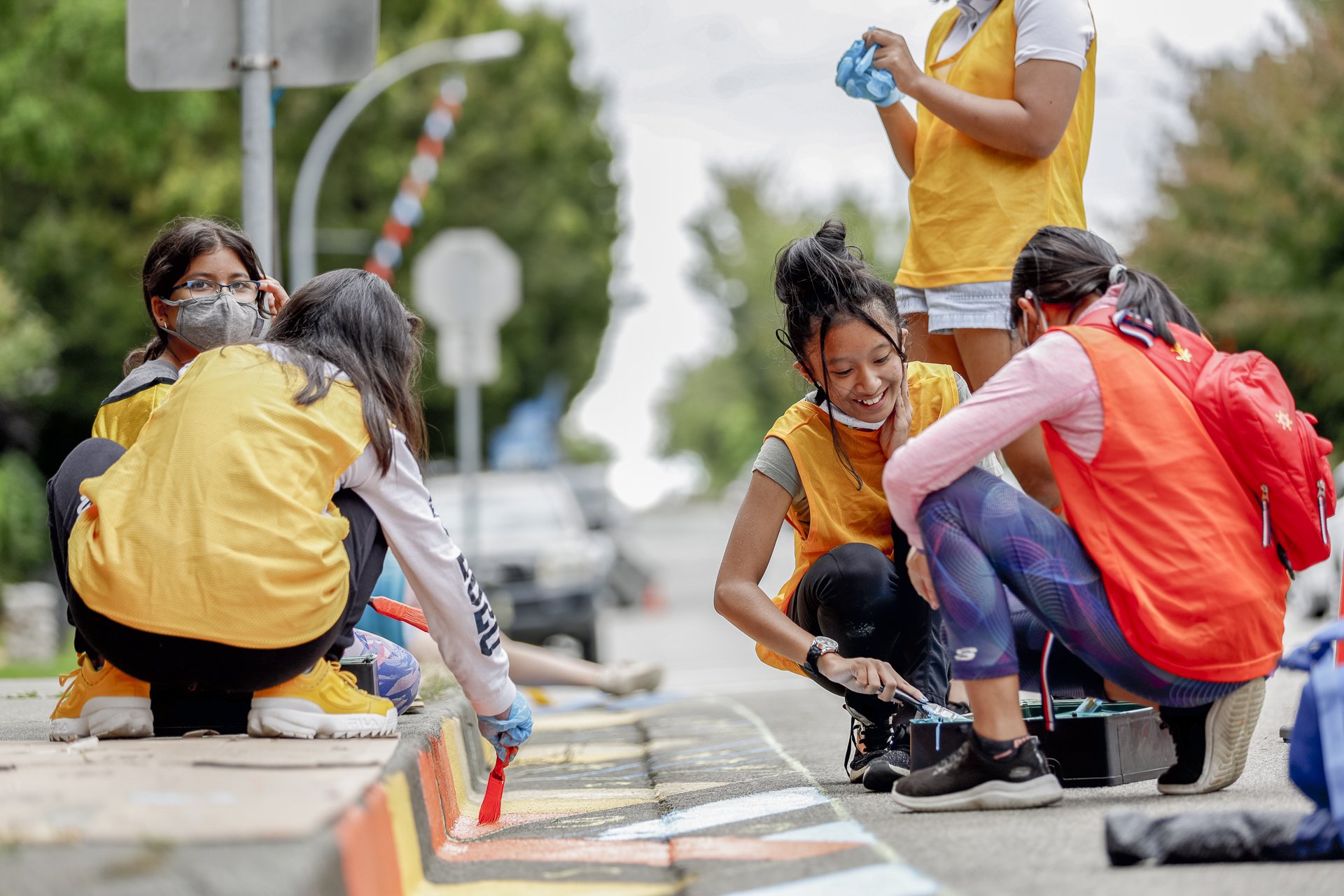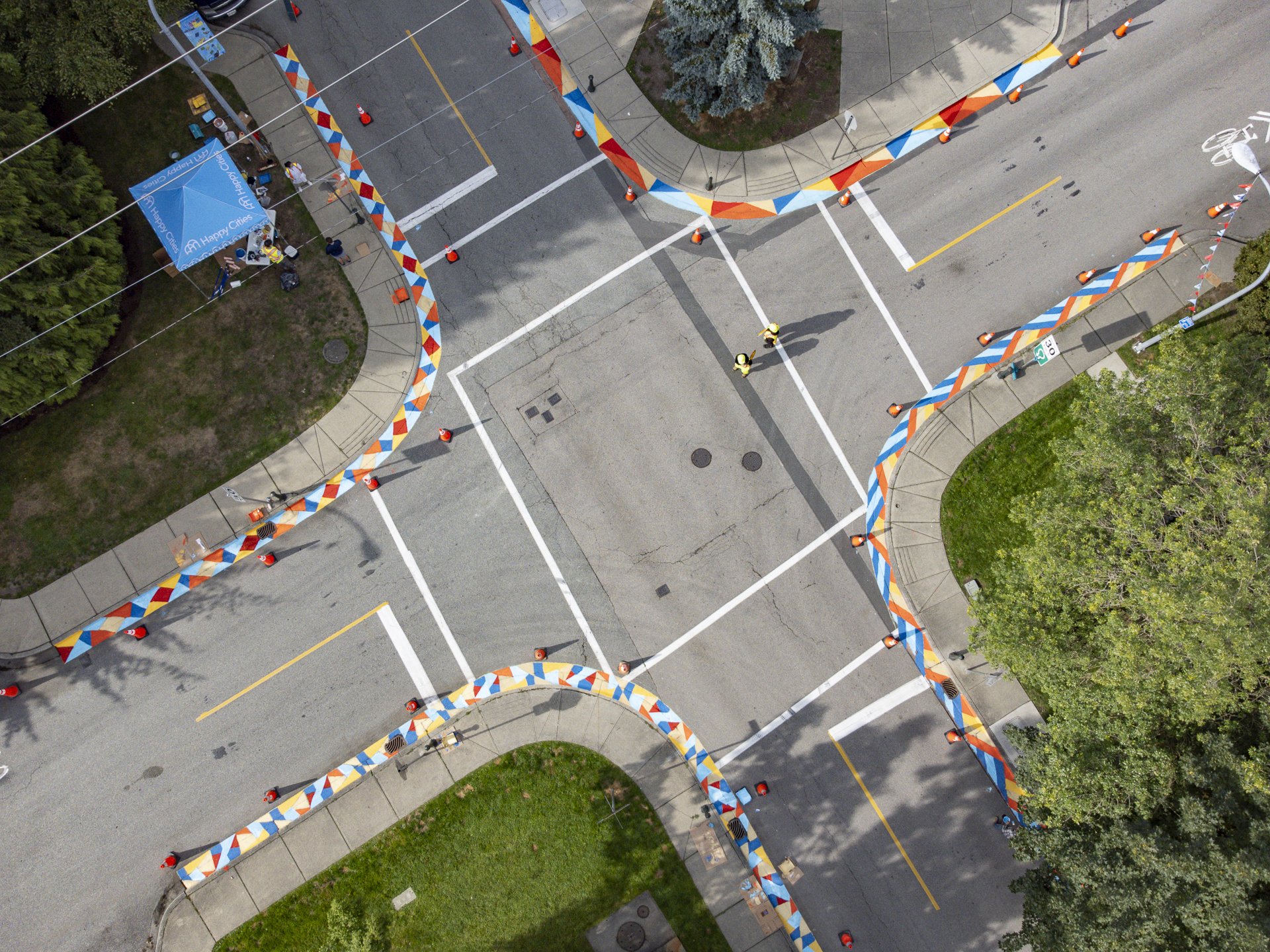For happier, healthier communities, invest in placemaking
Placemaking creates opportunities for people to connect. (City of North Vancouver)
When the COVID-19 pandemic hit Silton, Saskatchewan—a community of less than 100 people—residents took action. A group of community volunteers noticed there was an empty space beside Town Hall on the village’s main street. Together, they came up with a vision for a new space that would allow physical distancing and social connection. With support from the Village Council, they applied for a grant and built a giant, wooden deck. They called it “The Platform,” in homage to the railroad tracks that run through the town.
The Platform is a simple space. It’s a large, free deck with good lighting and power outlets. Most importantly, it offers a central, outdoor space where residents can gather and connect—hosting everything from paint nights, to ukulele classes, flower shops, clothing exchanges, and more. An annual concert series at the Platform has become popular, drawing over 400 people from across the region.
Ukulele lessons and an evening concert at the Platform in Silton. (Aileen Martin)
This is placemaking.
The story of Silton is one of many we heard through our research on the impacts and value of placemaking across Canada.
Simply put, placemaking is when community members shape places. This could be by organizing an event or transforming a space—or both, like the Platform in Silton. Other examples include block parties, community gardens, benches, open streets and patios, colourful sidewalk crossings, and much, much more.
With placemaking, the process is just as important as the outcome. Placemaking offers opportunities to bring people together—sparking conversations between strangers and strengthening community connections—through working towards a shared goal. It gives people the power to shape their community. In turn, this process strengthens belonging and agency.
Harbour Road Neighbour Hub, with playful seating and emergency supplies. (Leah Karlberg)
Restaurant patio, lined with planter boxes and a little free library in Victoria. (Leah Karlberg)
Kids gather to watch a free outdoor play on a Montreal open street. (Emma Avery)
Anyone can be a placemaker
In 2020, a student wrote to the City of New Westminster, asking for traffic calming on the street by her school. The City listened, and offered funding for Happy Cities to help students at the middle school design bump-outs—curb extensions that reduce street space for cars and encourage drivers to slow down. After a competition organized by the art teacher, students painted the colourful, winning designs on the street. Beyond improving safety, the project strengthened the students’ sense of ownership at the school. As one student said, “I’m going to bring my kids back here in 20 years and show them how we made our street safer!”
Placemaking is open to everyone—even though not everyone uses the same lingo or calls themself a placemaker (or has even heard of the term “placemaking”).
Placemakers are young students and neighbours. They are community organizations, such as schools, faith-based groups, local businesses, and grassroots initiatives. And they are city staff.
Students paint curb bump-outs in New Westminster, boosting a sense of belonging—and traffic safety. (Jared Korb)
Why invest in placemaking?
Placemaking can play a key role in boosting community health, connection, resilience, and more. For example, street murals can help make streets safer for school kids. Community gardens can support food security for seniors. And both of these examples combat social isolation.
At Happy Cities, we often observe how people behave and interact in public spaces to understand how a change—like transforming an underused block for cars into a plaza for people—can increase people’s sense of trust, safety, and desire to connect with others. Our studies repeatedly show that people are more likely to want to meet friends and have spontaneous interactions with strangers in spaces that are comfortable—for example, places with seating, umbrellas, street art, and local shops.
Placemaking can also support economic, environmental, and public health goals. In cities across Belgium, temporary summer street closures led kids to play outside more—resulting in an extra hour of physical activity per day. A permanent street closure in Seoul, Korea cut air pollution by 35 per cent when an overpass was replaced with the Cheonggyecheon River Park. And a flexible street project in Lancaster, California has doubled pedestrian numbers and increased business sales by nearly 60 per cent.
These examples show how placemaking projects benefit residents, businesses, and local governments alike—contributing to connected, resilient, thriving communities with a high quality of life.
Cities in action
Many cities realize the benefits of placemaking and are working to support community-led initiatives. Cities can equip people to become placemakers by providing funding, offering community support, sharing practical resources, and making it easy to get involved.
Cities across Canada are supporting community-led initiatives in a number of ways:
Surrey, B.C. is developing an action plan to improve parks, open spaces, and streets and sidewalks across the Newton neighbourhood. Other successful initiatives have been as simple as adding covers to picnic tables, after hearing that residents would like to spend more social time at parks protected from the weather.
Covered seating at Surrey Chimney Heights Park. (City of Surrey)
Community pop-up event in Newton, Surrey. (Happy Cities)
In response to the COVID-19 pandemic, North Vancouver, B.C. launched an Open Streets program to expand public spaces, transforming vehicle traffic lanes into parklets. Our recent Public Life Studies found that the program is popular and welcoming to a range of people, particularly women, supporting the case for these spaces to become permanent.
Curb-side patio, as part of the North Vancouver Open Streets project. (City of North Vancouver)
Curb-side patio, as part of the North Vancouver Open Streets project. (City of North Vancouver)
Victoria, B.C. has developed a Placemaking Toolkit to inspire and provide resources to residents. The toolkit provides practical resources for a range of small-, medium-, and large-scale placemaking projects. A catalogue of pre-approved “elements” aims to remove barriers for implementation.
Placemaking in action. (City of Victoria)
Kingston, Ontario has developed the Safe Streets Playbook as a step-by-step guide for schools that are interested in closing streets during peak hours to improve safety and access.
Halifax and the province of Nova Scotia have creatively animated the downtown waterfront, using beach chairs, obstacle courses, small business kiosks, major public art, and landscape changes. Through small investments over time, they have transformed the waterfront from an industrial workplace into a beloved community heart.
A lively patio space on the waterfront. (Tristan Cleveland / Happy Cities)
Orange hammocks on the waterfront. (Tristan Cleveland / Happy Cities)
The power of placemaking
Placemaking is simple and easy to implement. And, it’s one of the most cost-effective ways to boost a sense of community and encourage new social ties. Cities have an important role to play in this ecosystem of placemaking. Cities can lead this charge by supporting their community’s initiatives and removing barriers.
This work isn’t just “feel good” or “nice to have.” Rather, it’s essential to support community wellbeing—especially as cities face growing uncertainty around economic stability, the climate crisis, and social isolation. It’s time for municipalities across Canada to recognize the power of placemaking.
Discover more on the Power of Placemaking here.















